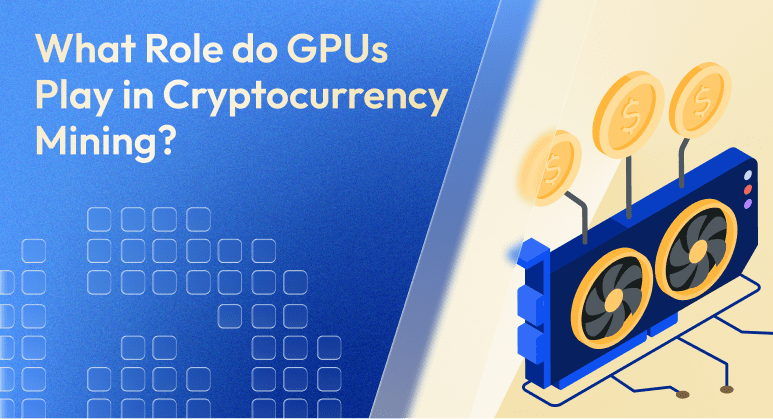Bitcoin was the first proof-of-work (PoW) cryptocurrency in 2009. Initially, you could “mine” for bitcoins using only your home computer. Cryptocurrency mining became a reality for many on their home computers as technology evolved to keep up with the hectic demand. With the use of better gear, the mining process and its efficiency have increased over time. For years, graphics processing units (GPUs) have been utilized in mining since they were more efficient than their nearest equivalents.
GPUs are still an efficient way to mine specific tokens. Let’s explore to find out more about how GPUs have been used in the blockchain space.
What is a GPU(Graphic Processing Unit)
A GPU, or Graphics Processing Unit, is a specialized electronic circuit that produces images, animations, and films on computer displays. It’s an integral part of current computers and devices, particularly those utilized for gaming, graphics creation, video editing, and other visually demanding jobs.
Yet, GPUs aren’t just for visuals. They are also ideally suited for parallel processing jobs, in which numerous calculations or operations can be executed at the same time. This property has led to GPUs being utilized for purposes other than graphics, such as scientific models, artificial intelligence, deep learning, and cryptocurrency mining.
Key Points
- The digital offering in a computer system is handled by a GPU, or graphics processing unit.
- Because of the power potential of a GPU in comparison to a CPU, or central processing unit, they have become more effective in blockchain mining due to their speed and efficiency.
- The rapid pace of technical innovation will determine if GPUs continue to be the norm for high-level Bitcoin mining.
What Role do GPUs Play in Crypto Mining?
Originally, cryptocurrency mining was done with CPUs, or Central Processing Units. However, the CPU-based mining process was inefficient because of its slow processing speed and high power usage.
Enter GPU-based mining, which provided numerous benefits over the use of CPUs. A common GPU, such as a Radeon HD 5970, clocked processing speeds of 3,200 32-bit instructions per clock, which was 800 times faster than a CPU that only performed 4 32-bit instructions per cycle.
This aspect of the GPU makes them proper and more suitable for cryptocurrency mining, as the mining process needs greater efficiency in doing comparable types of repetitive computations. The mining gadget constantly attempts to decode the various hashes, with only one digit changing on each try.
GPUs also have a high number of Arithmetic Logic Units (ALU), which are in charge of conducting mathematical computations. Because of these ALUs, the GPU can conduct more calculations, resulting in more output for the crypto-mining process.
GPU Vs CPU
Every ordinary computer has a Central Processing Unit (CPU), which is a processing device that serves as the master of the entire computer system. It controls the entire computer based on the logic of the operating system and the software loaded on the machine. The CPU controls common functions such as saving this file as MS Word, printing this spreadsheet, and playing that film in VLC Media Player.
A GPU is another type of computing device, although it only handles display functions. It is the component of a computer that is in charge of the video-creating system.
A GPU’s typical job is to produce visual effects and 3D graphics so that the CPU does not have to get involved in minute details of video-rendering services. It handles graphics-intensive operations including video editing, game display, and 3D video and animation decoding and graphics.
To use a common example, the master (CPU) who controls the entire organization (the computer system) has an assigned worker (GPU) who leads a specialized department (video-rendering operations).
This setup allows the CPU to handle high-level diverse activities for managing the entire computer, while the GPU handles the video operations for which it is a specialist. The CPU will execute the role of opening a video file in Windows Media Player, but after the file is opened, the GPU will take over the task of properly displaying it.
Can GPUs still be used to mine Cryptocurrency?
Certain ASIC-resistant tokens can still be mined using GPUs. For other PoW tokens, ASICs now beat GPUs, effectively rendering them useless. The most recent ASIC miners can produce nearly 200 TH/s while using only 27.5 joules per tera hash.
While the crypto ecosystem has changed over time, GPUs continue to be a popular choice for cryptocurrency mining. They excel in performing complex mathematical calculations required for mining various cryptocurrencies, particularly those based on Ethereum’s Et hash algorithm.
However, there are a few things to think about. The cryptocurrency mining scene has become more competitive, making mining coins purely with GPUs more difficult. Bitcoin mining, for example, has switched to specialized gear known as ASICs, making GPUs less effective.
However, many altcoins (cryptocurrencies other than Bitcoin) are still GPU-mineable. Ethereum, the second-largest cryptocurrency, currently employs the Ethash algorithm, which lends itself well to GPU mining. Because of their memory-intensive algorithms, other coins like Litecoin and Ravencoin also favor GPU mining.
The Bottom Line
GPUs have been around for years, but they are being challenged by more effective, new-age technology. They include Field Programmable Gate Arrays (FPGAs) and Application Specific Integrated Circuits (ASICs), which surpass both CPUs and GPUs at performing hash calculations, an important function in cryptocurrency blockchain operations.
GPUs can contribute to the mining of other cryptocurrencies in addition to Bitcoin, giving miners the flexibility to move between coins dependent on profitability. Furthermore, GPUs are readily available and affordable, making them a viable option for individual miners and smaller operations.
Furthermore, GPUs are still required for operations such as transaction validation on the Bitcoin network, which contributes to its decentralized nature. Their computer capacity contributes to the blockchain’s security and efficiency by confirming transactions and upholding confidence.
While ASICs continue to dominate the Bitcoin mining industry, GPUs continue to demonstrate their versatility and importance in the larger cryptocurrency environment. As technology advances and fresh challenges emerge, the role of GPUs in the Bitcoin world is likely to grow further, reflecting the dynamic character of this ever-changing area.


